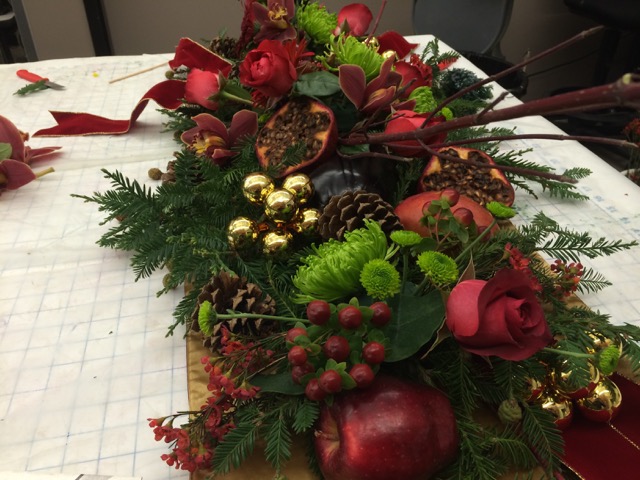The Local newsletter is your free, daily guide to life in Colorado. For locals, by locals.
The countdown to Thanksgiving dinner has officially begun. And for most of us, that means hitting several different grocery stores to track down everything from turkey and sweet potatoes to green beans and pie filling. This year, try to save a little room in your cart. Of course, the turkey always gets top billing, but how about letting flowers steal the tabletop spotlight?
We asked Marilyn Quigley, an instructor at Emily Griffith Technical College, to create a floral design for the holidays using easy-to-find supplies. Quigley, a pro with more than 30 years of industry experience, always recommends a quick trip to the neighborhood flower shop for the freshest blooms and specialty flowers. But given the time crunch many of us find ourselves in just before the big day, she relied on common blooms that are often readily available at the grocery store to create this elegant horizontal design, a step up from your everyday flowers in a vase. “Don’t be intimidated,” Quigley says. “Once you get started, it’s easy and fun, and I promise it’s going to turn out beautifully.” And for some of the goods, you won’t have to travel farther than your backyard: Simply grab your garden scissors and cull evergreen or juniper branches for a perfect seasonal base.


Supplies:
- Three medium-size Tupperware containers
- A couple of blocks of floral foam (sold at hobby shops)
- Scissors and a craft or kitchen knife
- Evergreen or juniper branches
- Kitchen skewers
- An assortment of fruit (try grapes, apples, mangos, pomegranates, or eggplants)
- A few handfuls of your choice of greenery and blooms, such as gerbera daisies, roses, waxflowers, green spider mums, and hypericum berry
- Pinecones, ornaments, ribbon, or other miscellaneous holiday decor
- Sticks (whatever is available in your yard)
1) Prep in place: This display should be created “in place,” which means directly on your holiday table. (Better to assemble the day before your event.) Lay your tablecloth and table runner before building your design. Determine how much space you’ll need on the table, and choose three Tupperware containers to anchor the flowers. Plastic is fine; the containers won’t be seen.

2) Start at the bottom: Cut the floral foam to fit your Tupperware, then soak the foam blocks in water before placing them in your containers. Begin with the large foliage (in this case, evergreen branches) cut to size with a kitchen knife or scissors and start poking branches into the foam along the entire edge of the container, creating a nice base of greenery. Try to imagine a rectangular shape so the branches are longer on the ends and kept shorter on the front and back.

3) Add fruit: Look for large fruit in complementary colors to your floral selections. Quigley used mango, red grapes, pomegranate, eggplant, and red delicious apples. Enlist kitchen skewers (cut in half) to anchor grapes into the foam. The grapes will sit a few inches above the evergreen blanket. Apples can also be skewered into the foam. The large fruit should be placed between the evergreen branches directly on the table.
4) Check height: Quigley recommends this arrangement stand no higher than the length from your elbow to finger tip, for conversation’s sake. Just rest your elbow on the table to measure.

5) Incorporate blooms: Trim your blooms—here, gerbera daisies, roses, waxflowers, green spider mums—and start placing them in the floral foam. Keep the stems of the larger blossoms (daisies and roses) to just a few inches, and these focal flowers will start covering the green foam. Finally, take the smaller flower heads (mums, green button pom poms, and hypericum berry) and place them “longer” in the foam (meaning, sitting higher with more stem showing compared to the smaller, focal flowers). When in doubt, just keep inserting flowers until the foam is covered. Quigley stuck with an elegant, monochromatic theme for her flowers and fruit.

6) Place the finishing touches: When the floral foam no longer shows and you’re happy with the composition, use a few pinecones and a pomegranate cut in half to help brighten the evergreen blanket. Place them directly onto the table and fill in any empty space. Feel free to add seasonal decorations such as ribbons or ornaments skewered into the foam. Quigley also created small votive candleholders out of the red delicious apples.

7) Branch out: The long red twig dogwood pieces (or whatever sticks are in your yard) are added last; again, simply poke them into the floral foam. The sticks emphasize the horizontal design, which is a creative upgrade from vase-based arrangements. Bonus: It looks like you had an in-house visit from the professionals. Your guests will never guess it was a DIY project—created by you for a fraction of the price. And that’s something to be thankful for.
Emily Griffith Technical College offers an extensive curriculum of certification courses and continuing education; floral design is just one of the college’s many offerings. A Colorado public college, Emily Griffith will celebrate its 100th anniversary in September 2016.








